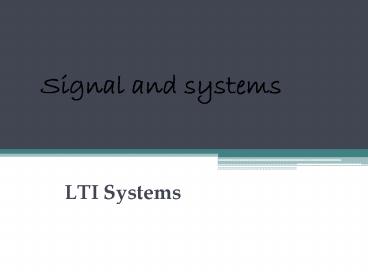Signal and systems - PowerPoint PPT Presentation
1 / 31
Title:
Signal and systems
Description:
Signal and systems LTI Systems * * * * * * * * * * * * * * * * * * * * * * * * * * * * * * * Linear Time-Invariant Systems Linear Memoryless A system is memoryless if ... – PowerPoint PPT presentation
Number of Views:98
Avg rating:3.0/5.0
Title: Signal and systems
1
Signal and systems
- LTI Systems
2
Linear Time-Invariant Systems
3
Linear
4
(No Transcript)
5
(No Transcript)
6
(No Transcript)
7
(No Transcript)
8
(No Transcript)
9
(No Transcript)
10
(No Transcript)
11
(No Transcript)
12
(No Transcript)
13
(No Transcript)
14
(No Transcript)
15
Memoryless
- A system is memoryless if its output any time
depends only on the value of input at that same
time - For LTI system
- If h(n)0 for n 0
16
Invertiblity
x(t)
y(t)
h(t)
- This implies that
- h(n) (n) (n)
17
(No Transcript)
18
(No Transcript)
19
(No Transcript)
20
(No Transcript)
21
(No Transcript)
22
(No Transcript)
23
(No Transcript)
24
Memoryless
- A system is memoryless if its output any time
depends only on the value of input at that same
time - For LTI system
- If h(t)0 for t 0
25
Invertiblity
x(t)
y(t)
h(t)
- X(t)(h(t)h (t))x(t)
- This implies that
- h(t) (t) (t)
26
Stability
27
Causality
28
Causality Stability-Example
29
Summary of Convolution
30
Summary of Convolution
- The convolution sum operation involves the
following four steps - 1. The impulse response hk is time-reversed
(that is, reflected about the origin) to obtain h
- k and then shifted by n to form hn - k
h-(k - n) which is a function of k with
parameter n. - 2. Two sequences x k and hn - k are
multiplied together for all values of k with n
fixed at some value. - 3. The product x k h n- k is summed over
all k to produce a single output sample ynI. - 4. Steps 1 to 3 are repeated as n varies over - 8
to 8 to produce the entire output yn.
31
Summary of Convolution
- The convolution integral operation involves the
following four steps - 1. The impulse response h(t) is time-reversed
(that is, reflected about the origin) to obtain
h(t) and then shifted by t to form h(t - t )
h-(t - t) which is a function of t with
parameter t. - 2. The signal x (t) and h (t - t ) are multiplied
together for all values of r with t fixed at some
value. - 3. The product x (t) h (t-t) is integrated over
all t to produce a single output value y (t). - 4. Steps 1 to 3 are repeated as t varies over - 8
to 8 to produce the entire output y (t).































